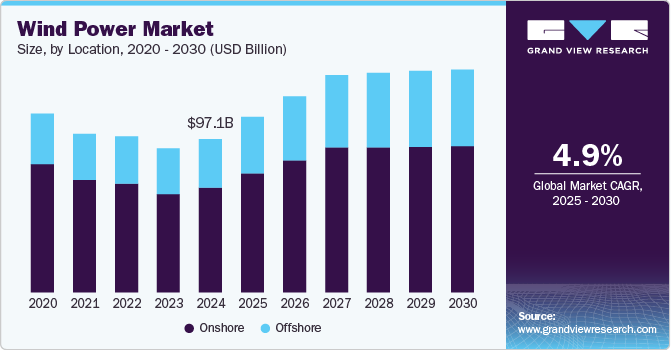Wind Power Market Size, Share & Trends Analysis growing at a CAGR of 4.9% from 2025 to 2030

The global wind power market size was estimated at USD 97.05 billion in 2024 and is projected to reach USD 141.09 billion by 2030, growing at a CAGR of 4.9% from 2025 to 2030. The growing need to replace conventional sources of energy with renewable sources is projected to drive the market for wind power in the upcoming years.
Key Market Trends & Insights
- Asia Pacific dominated the wind power market with the largest revenue share of 40.71% in 2024.
- The wind power market in the U.S. is anticipated to grow at the fastest CAGR during the forecast period.
- Based on location, the on-shore segment led the market with the largest revenue share of 75.52% in 2024.
- Based on application, the utility segment led the market with the largest revenue share of 83.5% in 2024.
Market Size & Forecast
- 2024 Market Size: USD 97.05 Billion
- 2030 Projected Market Size: USD 141.09 Billion
- CAGR (2025-2030): 4.9%
- Asia Pacific: Largest market in 2024
Request a free sample copy or view report summary: https://www.grandviewresearch.com/industry-analysis/wind-power-industry/request/rs1
Solar and wind power generation, which were considered expensive two decades ago, are now considered more cost-competitive than new-built coal or gas plants today. Moreover, in the coming years, it is expected to become more cost-efficient to build new wind and solar than to run existing coal or gas plants. The urge for dependable, clean, and cheap power is expected to drive market growth in the future. Favorable policy structures and regulatory frameworks by various governments across various countries to promote renewable power generation are further expected to propel the market globally.
Drivers, Opportunities & Restraints
The market is primarily driven by several key factors, including government policies and incentives, technological advancements, and growing environmental concerns. Governments worldwide are implementing supportive frameworks such as tax credits, feed-in tariffs, and renewable energy targets to stimulate investment in wind energy.
Technological innovations have led to decreased costs and improved efficiency of wind turbines, making wind energy increasingly competitive with traditional fossil fuels23. In addition, the urgent need to address climate change and reduce carbon emissions has heightened the demand for clean energy sources, further propelling the growth of the wind power sector globally.






